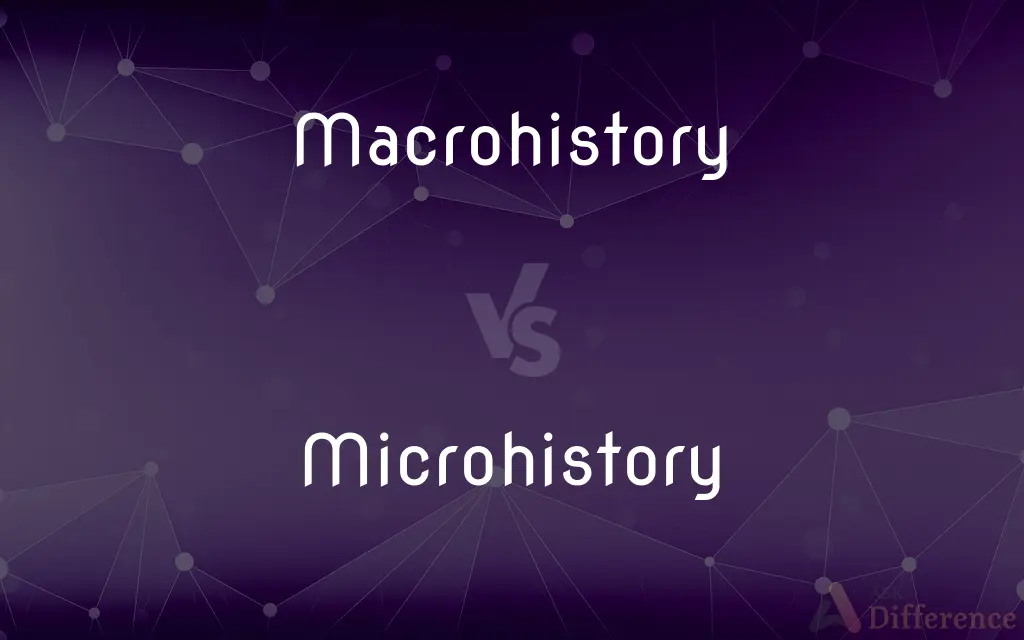Macrohistory vs. Microhistory — What's the Difference?
By Tayyaba Rehman & Maham Liaqat — Updated on April 22, 2024
Macrohistory focuses on broad historical patterns and long-term processes across civilizations, while microhistory delves into the details of small-scale events or the lives of obscure individuals.

Difference Between Macrohistory and Microhistory
Table of Contents
ADVERTISEMENT
Key Differences
Macrohistory examines large-scale phenomena and the grand narratives of history, analyzing how civilizations and major historical trends develop over centuries. On the other hand, microhistory focuses on minute, often overlooked details, providing deep insights into the daily lives and social structures of specific groups or individuals during a particular period.
In macrohistory, the scope is typically vast, covering entire civilizations or major historical movements such as the Renaissance or Industrial Revolution. Whereas microhistory might concentrate on a single village, a family, or even an individual's life story to reveal broader societal truths.
Macrohistorians often utilize theories and models to understand historical changes, looking for patterns and causes that affect large populations. In contrast, microhistorians frequently employ narratives or reconstruct events from limited or localized sources, emphasizing the complexity and uniqueness of human experiences.
The methodologies in macrohistory tend to involve quantitative data, such as economic statistics or demographic information, to support large-scale analyses. Conversely, microhistory might rely more on qualitative data like personal letters, court records, or detailed case studies, highlighting individual or community behaviors.
While macrohistory provides a framework for understanding major historical shifts and the evolution of societies, microhistory offers a microscopic view that challenges or complements these broader narratives by showing the impact on and the role of ordinary people.
ADVERTISEMENT
Structured Comparison Table:
Comparison Chart
Scope
Broad, covering large groups or eras
Narrow, focusing on specific events or individuals
Focus
General patterns and major trends
Detailed, often anecdotal insights
Methodology
Quantitative analysis, theories
Qualitative analysis, case studies
Source Material
Statistical data, broad literature
Personal documents, localized records
Objective
Understand large-scale changes
Highlight specific, often overlooked, details
Compare with Definitions
Macrohistory
A study of history that focuses on large-scale events and processes.
Macrohistory explores the development of entire civilizations.
Microhistory
A detailed study of a specific event or individual within a narrow context.
Microhistory investigates the life of an unknown medieval craftsman.
Macrohistory
Concerned with broad historical movements and trends.
Macrohistory analyzes how the Enlightenment influenced various societies.
Microhistory
Focuses on uncovering the ordinary or obscure aspects of history.
Microhistory explores the daily routines in a 17th-century village.
Macrohistory
Uses models and theories to explain historical changes.
Macrohistorians apply the theory of economic cycles to understand past economic behaviors.
Microhistory
Relies heavily on detailed archival research.
Microhistorians analyze personal letters to understand social relations.
Macrohistory
Often involves comparative history across different regions or times.
Macrohistory compares the industrialization of Europe and Asia.
Microhistory
Provides an intimate, human-scale perspective of history.
Microhistory examines how a specific law affected one community.
Macrohistory
Aims to provide a contextual understanding of major events.
Macrohistory examines the causes and effects of World Wars.
Microhistory
Challenges broader historical narratives by focusing on the specifics.
Microhistory reveals exceptions to widely accepted historical theories.
Macrohistory
Macrohistory seeks out large, long-term trends in world history in search of ultimate patterns by a comparison of proximate details. It favors a comparative or world-historical perspective to determine the roots of changes as well as the developmental paths of society or a historical process.A macrohistorical study might examine Japanese feudalism and European feudalism to decide whether feudal structures are an inevitable outcome because of certain conditions.
Microhistory
Microhistory is a genre of history that focuses on small units of research, such as an event, community, individual or a settlement. In its ambition, however, microhistory can be distinguished from a simple case study insofar as microhistory aspires to "[ask] large questions in small places", according to the definition given by Charles Joyner.
Macrohistory
A form of large-scale history dealing with large groups of cultures over very long time periods.
Microhistory
The study of the past on a small scale, such as an individual neighborhood or town, as a case study for general trends.
Common Curiosities
What is an example of a microhistorical study?
An example is the study of a single event, like a witch trial in a small European town, to explore broader issues of gender, power, and social norms.
What are the typical time spans covered in macrohistory studies?
Macrohistory often covers centuries or even millennia, examining long-term trends and processes in historical development.
How do the sources used in microhistory enhance historical narratives?
Microhistory sources, such as diaries or local records, provide personal and detailed perspectives that can offer a more nuanced understanding of historical events.
Can microhistory challenge existing historical theories?
Yes, microhistory can challenge broader historical theories by providing counterexamples or detailed cases that do not fit general patterns.
How are technological changes typically analyzed in macrohistory?
Technological changes are analyzed in macrohistory as driving forces of economic, social, and cultural shifts on a large scale.
How do macrohistorians view the significance of single events compared to broader trends?
Macrohistorians generally view single events as less significant on their own, focusing more on how these events illustrate or affect broader historical trends.
What is the impact of globalization on macrohistory studies?
Globalization impacts macrohistory studies by broadening the scope to include transnational processes and interactions across different regions and cultures.
How does microhistory contribute to our understanding of social structures?
Microhistory provides insights into the fabric of everyday life and social structures by studying the behaviors, interactions, and experiences of individuals or small groups.
What role do individual stories play in microhistory?
Individual stories are central to microhistory as they highlight the human experience and personal dimensions of historical events.
Why is macrohistory important in the field of history?
Macrohistory is important because it helps historians and scholars understand large-scale patterns and influences that shape civilizations and global changes.
What skills are particularly important for a microhistorian?
Skills such as attention to detail, patience in research, and the ability to interpret small data sets critically are crucial for microhistorians.
How does macrohistory handle the complexity of historical change?
Macrohistory often uses models and theories to simplify and explain complex historical changes across large populations and time periods.
What type of publication would typically result from microhistorical research?
Microhistorical research often results in detailed case studies or narrative-driven publications focusing on specific events or individuals.
What challenges do macrohistorians face in their research?
Challenges include dealing with vast amounts of data, avoiding oversimplification, and connecting disparate historical phenomena into coherent narratives.
Can microhistory influence public perception of history?
Yes, microhistory can influence public perception by highlighting lesser-known aspects of history and emphasizing the relevance of individual experiences.
Share Your Discovery

Previous Comparison
Gigawatt vs. Megawatt
Next Comparison
Landlady vs. MistressAuthor Spotlight
Written by
Tayyaba RehmanTayyaba Rehman is a distinguished writer, currently serving as a primary contributor to askdifference.com. As a researcher in semantics and etymology, Tayyaba's passion for the complexity of languages and their distinctions has found a perfect home on the platform. Tayyaba delves into the intricacies of language, distinguishing between commonly confused words and phrases, thereby providing clarity for readers worldwide.
Co-written by
Maham Liaqat















































